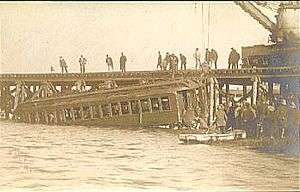1906 Atlantic City train wreck
 Car 6704 being removed from the water | |
| Date | October 28, 1906 |
|---|---|
| Time | 2.20 pm |
| Location | Atlantic City, New Jersey |
| Country | United States |
| Rail line | West Jersey and Seashore Railroad |
| Operator | Pennsylvania Railroad |
| Type of incident | Derailment |
| Cause | Draw (swing) bridge locking failure |
| Statistics | |
| Trains | 1 |
| Passengers | 87 |
| Deaths | 53 |
The 1906 Atlantic City train wreck occurred in Atlantic City, New Jersey, on Sunday October 28, 1906, when a West Jersey and Seashore Railroad electric train fell off a draw (swing) bridge, drowning 53 people.[1][2][3]
Accident
The newly constructed bridge crossed The Thoroughfare, a creek separating Atlantic City from the mainland. On Sunday, October 28, 1906, the bridge had been opened to allow a small vessel to pass. The signals protecting the bridge were interlocked, meaning that the signals only showed clear after the bridge was back in place for rail operation.
At 2.20 pm the first eastbound train, which had left Camden an hour earlier,[4] attempted to cross, but as it moved onto the bridge at a speed of 40 mph it derailed. After bumping along the ties (sleepers) for a few seconds the first two cars plunged 15 feet into the water. With doors shut and connecting doors closed, the passengers had very little chance to escape. The trailing car remained hanging from the bridge superstructure for a brief time before slipping into the water. The brakeman traveling in this third car rushed to open the rear door as soon as the train left the rails, and held it open to allow many passengers to escape, with only one or two escaping from the first two cars. Both men and women broke windows in attempts to get free, several returning selflessly to rescue others as well as themselves.[5] It was to the rear car that rescue efforts were soon directed, both from boats and from ropes let down from the bridge.
A crowd of between 5,000 and 10,000 gathered within 30 minutes, many of whom had been expecting the arrival of relatives and friends on the train, the terminal being but a short distance away.[4] Fortunately 14 passengers had left the train at the previous stop, Pleasantville, but in all 53 people drowned in the tragedy.[1]
Cause
The operation of the bridge had been tested after electrification of the line only one month before,[1] and a westbound train had already crossed without incident after the opening of the drawbridge. Investigation revealed later that the interlocking of the signals only worked on the bridge's lateral positioning, not on its height. In order to disengage, the bridge was raised slightly; on this occasion it had not returned to the correct level. The weight of the westbound train had depressed the bridge, so allowing it to pass, but the same had not happened for the eastbound, leaving two of its shiny new carriages totally submerged in thirty feet of water.
The accident resulted in what is regarded as the first press release when public relations expert Ivy Lee, working with the Pennsylvania Railroad, parent company of the West Jersey and Seashore Railroad, convinced the company to present a statement to journalists at the scene of the accident. The New York Times printed the release word-for-word on October 30, 1906.[6]
See also
References
- 1 2 3 Haine
- ↑ Bianculli
- ↑ Reed
- 1 2 http://www3.gendisasters.com/new-jersey/1162/atlantic-city,-nj-electric-train-wreck,-oct-1906 New York Times, 29 Oct 1906
- ↑ https://news.google.com/newspapers?nid=38&dat=19061029&id=NnM6AAAAIBAJ&sjid=FCoMAAAAIBAJ&pg=1602,4757719 St John Sun, Monday October 29, 1906
- ↑ http://inventors.about.com/od/pstartinventions/a/press_release.htm Press Release
- Bianculli, Anthony J. (2008). Iron Rails in the Garden State: tales of New Jersey railroading. Bloomington, IN: Indiana University Press. pp. 125–127. ISBN 978-0-253-35174-6.
- Haine, Edgar A. (1993). Railroad Wrecks. Associated University Presses. pp. 68–69. ISBN 0-8453-4844-2.
- Reed, Robert C. (1968). Train Wrecks: A Pictorial History of Accidents on the Main Line. New York: Bonanza Books. pp. 90, 100. ISBN 0-517-32897-6.
Coordinates: 39°21′52″N 74°26′44″W / 39.36444°N 74.44556°W